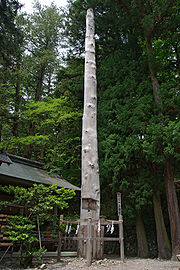
Onbashira
Encyclopedia

Lake Suwa
is a lake in the central part of Nagano Prefecture, Japan. It ranks 24th in Japan in surface area.Lake Suwa is the site of , an interesting natural phenomenon. The lake has a natural hot spring under the surface, so that when the top freezes in the winter, the lower waters are still warm and...
area of Nagano, Japan
Japan
Japan is an island nation in East Asia. Located in the Pacific Ocean, it lies to the east of the Sea of Japan, China, North Korea, South Korea and Russia, stretching from the Sea of Okhotsk in the north to the East China Sea and Taiwan in the south...
. The purpose of the festival is to symbolically renew the Suwa Taisha
Suwa Taisha
, or Suwa Grand Shrine, is a Shinto shrine in Nagano prefecture, Japan. Over 1200 years old, it is one of the oldest shrines in existence, and is mentioned in the Kojiki, an 8th century text...
or Suwa Grand Shrine. "Onbashira" can be literally translated as "the honored pillars".
The Onbashira festival is reputed to have continued, uninterrupted, for 1200 years. The festival is held once every six years, in the years of the Monkey and the Tiger in the Chinese Zodiac
Chinese zodiac
The Shēngxiào , better known in English as the Chinese Zodiac, is a scheme that relates each year to an animal and its reputed attributes, according to a 12-year mathematical cycle...
, however the locals may say "once in seven years," because of the traditional Japanese custom of including the current year when counting a length of time.
Onbashira lasts several months, and consists of two segments, Yamadashi and Satobiki. Yamadashi traditionally takes place in April, and Satobiki takes place in May.
"Yamadashi" literally means "coming out of the mountains." Before this portion of the festival, huge trees are cut down in a Shinto
Shinto
or Shintoism, also kami-no-michi, is the indigenous spirituality of Japan and the Japanese people. It is a set of practices, to be carried out diligently, to establish a connection between present day Japan and its ancient past. Shinto practices were first recorded and codified in the written...
ceremony using axes
Axe
The axe, or ax, is an implement that has been used for millennia to shape, split and cut wood; to harvest timber; as a weapon; and as a ceremonial or heraldic symbol...
and adzes
Adze
An adze is a tool used for smoothing or carving rough-cut wood in hand woodworking. Generally, the user stands astride a board or log and swings the adze downwards towards his feet, chipping off pieces of wood, moving backwards as they go and leaving a relatively smooth surface behind...
specially manufactured for this single use. The logs are decorated in red and white regalia, the traditional colors of Shinto ceremonies, and ropes are attached. During Yamadashi, Teams of men drag the logs down the mountain towards the four shrines of Suwa Taisha
Suwa Taisha
, or Suwa Grand Shrine, is a Shinto shrine in Nagano prefecture, Japan. Over 1200 years old, it is one of the oldest shrines in existence, and is mentioned in the Kojiki, an 8th century text...
. The course of the logs goes over rough terrain, and at certain points the logs must be skidded or dropped down steep slopes. Young men prove their bravery by riding the logs down the hill in a ceremony known as "Ki-otoshi."
"Satobiki" festival involves the symbolic placement of the new logs to support the foundation of the shrine buildings. The logs are raised by hand, with a ceremonial group of log bearers who ride the log as it is being raised and sing from the top of the log to announce the successful raising. This ceremony was performed as part of the opening ceremonies of the Nagano Olympics in 1998.
After two festivals, there is an important event "Building of Hoden". This event isn't generally famous, and few people know that the event is held even among people who live nearby and participate in Yamadashi and Satobiki. The end of this event marks the end of Onbashira.

